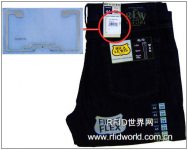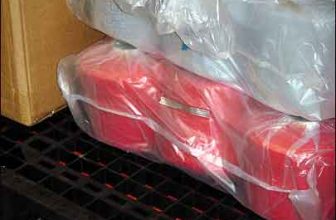
Walmart’s EPC project re-launched its first wave of RFID labeling of men’s jeans and underwear
[ad_1]
Recently, Wal-Mart has cooperated with suppliers to adopt RFID tags based on EPCglobal’s second-generation UHF RFID standard with EPC codes on men’s jeans and underwear. This measure is part of the next phase of Wal-Mart’s EPC project, which focuses on labeling products with multiple SKUs. The inventory management of multiple SKU products has always been a problem for retailers. According to Wal-Mart’s store responsible for the EPC project in the United States According to Innovation Director Myron Burke.

“We hope this labeling can improve the inventory accuracy and availability of this type of product,” Burke said. “We have strategically cooperated with suppliers to promote the development of this project.”
For the past 8 months, Wal-Mart has been cooperating with jeans and underwear suppliers to urge them to label their goods during the production stage so that they can benefit from product labeling the same as Wal-Mart. Unlike previous measures that required suppliers to label before a specific deadline, Wal-Mart is now working with suppliers to integrate EPC data into their warehouse management system to improve business processes and make full use of EPC labels to quickly and more accurately enter the warehouse. , Improve the accuracy of its own inventory, and reduce errors in picking and cargo transportation. At present, some suppliers have already labeled jeans and underwear, and the rest are expected to implement labeling before the end of this year.
Wal-Mart began to explain the labeling requirements to jeans and underwear suppliers at the beginning of this year. RFID tags must be embedded in use tags, labels or external packaging with the EPCglobal logo printed on the surface. When the product is sold, although Walmart employees will not remove or kill the label, the retailer expects that the customer will cut and discard the label before the product upper body. Wal-Mart prohibits suppliers from sewing tags into clothing, and store employees will not read tags at the checkout counter. In this way, EPC data cannot be matched with any personal information to achieve the purpose of protecting customer privacy.
Apparel products will be directly labeled when they are manufactured. When the goods arrive at the loading and unloading point of the retail store, they will be read by the workers when they are moved from the back-end warehouse to the store and put on the shelves. According to Burke, the new RFID hardware and software system can not only tell Wal-Mart which products need to be replenished, but it can also show when the products are on the shelf and when they are missing.
Burke declined to disclose the potential benefits that Wal-Mart or its suppliers may obtain in this labeling project, but said that the company’s pilot project shows that the use of EPC labels will improve inventory accuracy and product availability. According to the RFID Research Center of the University of Arkansas, the accuracy of RFID inventory has increased from 65% to 95%.
Currently, the new project does not require all clothing suppliers to label all individual items. Instead, Wal-Mart will work with suppliers of products with specific attributes to determine the benefits of EPC labeling. In this way, some clothing items-such as seasonal items that are only available for a few weeks-may not be labeled, while other items with the same characteristics as jeans and underwear will be labeled.
“We focus on labeling products that require more complicated purchase considerations,” Burke said. “For example, in the denim warehouse, in addition to the price, customers will consider the brand, style, size and tailoring when buying. Other products with similar characteristics include tires, electronic equipment, such as TVs, etc.
According to Burke, the company currently has no plans to label other similar products. Wal-Mart uses an upgradeable and easy-to-operate model to label jeans and underwear first, and then work with suppliers to label other types of goods.
“Product labeling is driven by commercial needs and interests,” Burke said. “After the positive effects of jeans and underwear labeling, we expect the management to further apply RFID tags to other products. But we are very concerned about labeling. For the impact on suppliers, we will give them time for labeling, process review and final process improvement. We don’t want to speed up the process unnecessarily and cause pressure on suppliers.”
Burke said that Wal-Mart has been studying how to profit from EPC technology, and the company will decide on the next labeling product category based on the commercial benefits of Wal-Mart and its suppliers.
Burke said that when all Wal-Mart stores in the United States implement the labeling of men’s jeans and underwear, the company will have difficulty judging the specific labeling volume because this number will fluctuate based on demand. However, he estimates that it will exceed 250 million per year. In addition, Sam Club does not participate in this project.
[ad_2]




